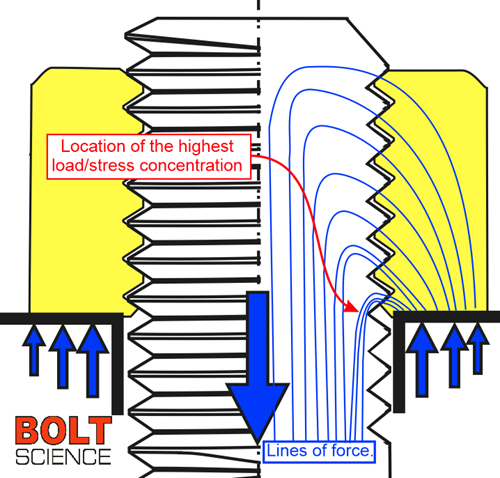
By Dr Bill Eccles of Bolt Science Ltd
Most engineers will likely come across a fatigue failure at some point in their career. Fatigue, which refers to the progressive cracking of a material due to repeated loading and unloading cycles, mainly occurs due to repeated change in the loading condition and subsequently, the stress condition.
A fatigue crack will normally form where the highest stress condition is located. For bolts, this is usually at the root of the thread closest to the nut-to-joint interface. The thread root is located at the bottom of the thread and is the region where the stress is significantly greater than the surrounding region – a feature known as a stress concentration. It can take thousands, or even millions of load cycles for the crack to propagate through the bolt. Ultimately, the smaller the stress concentration on the joint interface, the better the fatigue life in the bolt.
When bolts fail due to fatigue it is usually located in the first thread root next to the nut-to-joint interface. The reason why failure occurs here and not in another thread root is due to the high-level of loading on this region – as the load must pass between the joint, the nut and into the bolt. Because the loading takes the stiffest path, more loading passes through the first thread in the nut, a path which is demonstrated in Figure One.
joint, the nut and into the bolt. Because the loading takes the stiffest path, more loading passes through the first thread in the nut, a path which is demonstrated in Figure One.
The stress concentration in the thread root region is between 4 and 6 depending upon the pitch and diameter of the thread – meaning the stress can be 4 to 6 times the stress in the central section of the bolt thread.
Thread rounding increases bolt life
There are two main reasons why the root of the thread is rounded. Firstly, the rounding reduces the stress concentration and hence facilitates fatigue resistance. Secondly, since most bolt threads are rolled rather than cut, the rounding increases the life of dies used in the rolling process. It is advised that the thread root is fully rounded to facilitate prolonged bolt life.
Tolerances are placed on the root radii which, for metric threads, must be between 0.125p to 0.144p (where p is the thread pitch). Hence for an M6 coarse thread whose pitch is 1mm, the root radii must be between 0.125mm to 0.144mm. Limiting the radii to a minimum value, limits the stress concentration present.
Joint types – axially and shear loaded
The type of loading sustained by the joint influences the bolt’s load response. The majority of bolted joints that are shear loaded have clearance holes – where the hole is larger than the bolt thread to provide a radial gap between the bolt and the hole. Such joints rely upon the clamp force generated by tightening the bolt to transmit any shear by friction between the joint plates, as against shear being transmitted between the plates through the bolt shank. These joints are referred to as friction grip joints.
With such a joint, if designed and assembled correctly, the bolt will not experience a load change when the shear force is applied. Therefore, if there is no load change, there is no stress change in the bolt and hence no fatigue. If, however, the bolt is not tightened sufficiently, or the interface friction is low or the loading too high, the friction grip can be overcome and cause a joint slip. Fatigue failure in the thread root due to a shear loaded joint’s friction grip being overcome is a common, if not the most common, cause of bolt fatigue failure.
With an axially loaded joint, the bolt does not sustain the full magnitude of the applied loading as most of the loading reduces the clamp force. There is a small proportion of the loading, typically between 5% to 20%, that will be sustained by the bolt. If the axial loading varies, this will cause the stress sustained at the thread root to vary and hence cause fatigue. With a properly designed joint, the alternating stress sustained under axial loading is kept below the fatigue endurance limit of the bolt.
In an axially loaded joint, if the bolt was not tightened sufficiently, or the axial loading too high, the clamp force acting on the interface can be overcome. This results in a gap occurring in the joint interface, referred to as joint separation. The bolt would then sustain the full magnitude of the applied loading with potentially a large alternating stress in the thread root. Again, this is a common cause of fatigue failure.
In general, for both a shear and axially loaded joints, increasing the bolt preload will reduce the risk of fatigue failure occurring. Checking that the bolt has been tightened correctly is one of the first steps in a fatigue investigation. If the tightening was as specified, increasing the tightening torque and increasing the bolt strength is often second on the list when seeking to resolve a fatigue issue.
The BOLTCALC program by Bolt Science offers joint analysis and complete design checks to determine whether or not fatigue is a possibility in a bolt joint.

Becca is the latest member to join our team and is eager to get stuck into the world of fasteners. She brings an enthusiastic and fresh outlook on what we do editorially and will be leading our social media activity – including sourcing material, editing articles and posting online.





